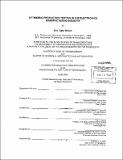| dc.contributor.advisor | Bernard C. Lesieutre and Roy E. Welsch. | en_US |
| dc.contributor.author | Nelson, Erik Tighe, 1964- | en_US |
| dc.contributor.other | Leaders for Manufacturing Program. | en_US |
| dc.date.accessioned | 2006-11-08T16:22:33Z | |
| dc.date.available | 2006-11-08T16:22:33Z | |
| dc.date.copyright | 2000 | en_US |
| dc.date.issued | 2000 | en_US |
| dc.identifier.uri | http://theses.mit.edu/Dienst/UI/2.0/Describe/0018.mit.theses%2f2000-66 | en_US |
| dc.identifier.uri | http://hdl.handle.net/1721.1/34706 | |
| dc.description | Thesis (S.M.)--Massachusetts Institute of Technology, Sloan School of Management; and, (S.M.)--Massachusetts Institute of Technology, Dept. of Aeronautics and Astronautics; in conjunction with the Leaders for Manufacturing Program, Massachusetts Institute of Technology, 2000. | en_US |
| dc.description | Also available online at the MIT Theses Online homepage <http://thesis.mit.edu>. | en_US |
| dc.description | Includes bibliographical references (p. 103). | en_US |
| dc.description.abstract | This thesis provides insight into methods for data analysis of testing procedures to optimize the overall testing times within the electronics manufacturing industry. By analyzing each test regime within the manufacturing sequence individually, with the goal of overall test time reduction, better test system optimization may occur. Specifically, within Burn In testing it was found that failure rates were heavily dependent upon the device on/off cycle. Once discovered new test cycles were proposed to reduce overall test times by 50%. Once implemented such new test cycles increased early failure capture as expected. In addition, industry benchmarking studies showed new forms of testing such as Highly Accelerated Stress Testing (HAST) are pushing the product testing earlier into the product life cycle where in-process tests such as Burn In may be reduced. In the case of HAST testing, the tests are being conducted in the design phase reducing more costly Burn In testing in the production phase. | en_US |
| dc.description.statementofresponsibility | by Erik Tighe Nelson. | en_US |
| dc.format.extent | 105 p. | en_US |
| dc.format.extent | 10872912 bytes | |
| dc.format.extent | 10872671 bytes | |
| dc.format.mimetype | application/pdf | |
| dc.format.mimetype | application/pdf | |
| dc.language.iso | eng | en_US |
| dc.publisher | Massachusetts Institute of Technology | en_US |
| dc.rights | M.I.T. theses are protected by copyright. They may be viewed from this source for any purpose, but reproduction or distribution in any format is prohibited without written permission. See provided URL for inquiries about permission. | en_US |
| dc.rights.uri | http://theses.mit.edu/Dienst/UI/2.0/Describe/0018.mit.theses%2f2000-66 | en_US |
| dc.rights.uri | http://dspace.mit.edu/handle/1721.1/7582 | |
| dc.subject | Sloan School of Management. | en_US |
| dc.subject | Aeronautics and Astronautics. | en_US |
| dc.subject | Leaders for Manufacturing Program. | en_US |
| dc.title | Optimizing product testing in the electronics manufacturing industry | en_US |
| dc.type | Thesis | en_US |
| dc.description.degree | S.M. | en_US |
| dc.contributor.department | Leaders for Manufacturing Program at MIT | en_US |
| dc.contributor.department | Massachusetts Institute of Technology. Department of Aeronautics and Astronautics | |
| dc.contributor.department | Sloan School of Management | |
| dc.identifier.oclc | 45502903 | en_US |
